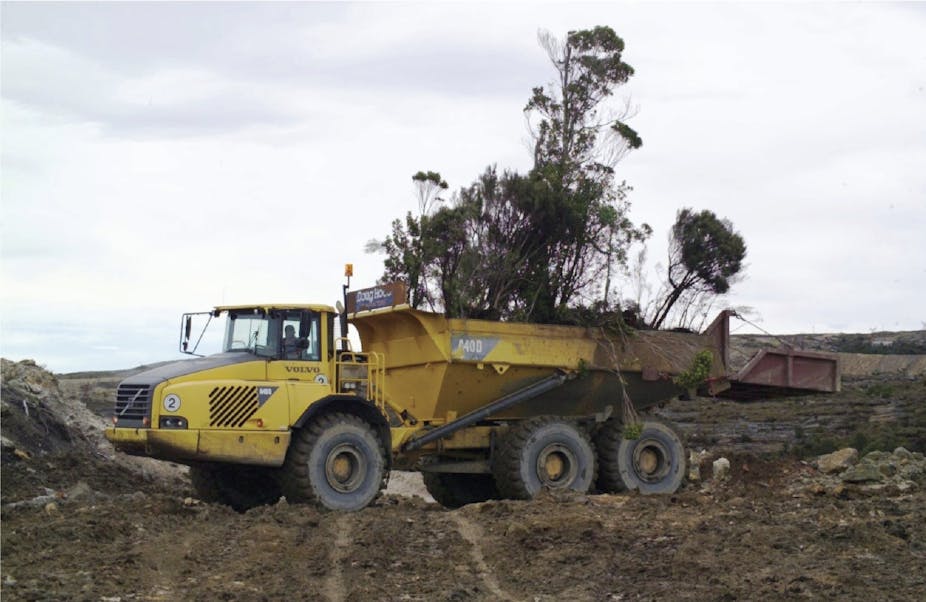Climate change poses a major threat to the world’s ecosystems. As the world warms, animals and plants will move to keep pace with their preferred climate, but many will be unable to keep up with the speed of change, particularly if humans are in the way.
Programs to move individual species to protect them from climate change already exist. But they are largely limited to those species that are conspicuous, large and charismatic (mostly mammals and birds).
In any given ecosystem, there could be thousands of species (many of which we still don’t know about). Those capable of migrating may have a chance of reaching more hospitable conditions but most species will not be able to cover the large distances required to find a different climate in the short period of time it will take for their environment to change. These ecosystems are effectively fated to disappear, unless of course they could be moved to a safer location.
Picking up and moving entire ecosystems at risk of being wiped out by climate change could be one way to preserve vulnerable plants, animals and insects. It may sound far-fetched, but actually this technique has already been used to deal with other human impacts.
Moving ecosystems
On the West Coast of New Zealand lies Stockton, the country’s biggest coal mine. Although mining activity has slowed down in recent years with the collapse of the market, the legacy of mining is still very visible.
Among the large areas of barren land, the enormous piles of soil and unsellable coal, there are small pockets of native vegetation. They look the same as the native vegetation outside the mine, but these little pockets of native grassland, shrubs or even forest are actually man-made.


They have been moved from an area that was about to be mined, to another area where mining had already been completed, using a process called ecosystem-scale translocation. Plants, soil and all microbes and animal communities they contain are picked up together in small soil sods that are moved out of the diggers’ way and reassembled to create a uniform native vegetation cover.
Ecosystem translocation is a restoration technique that hinges on the principle that instead of destroying native ecosystems and trying to recreate them piece by piece, it is easier and more efficient to carefully lift intact pieces of land and transport them to a safe location.
Now, what if we could do this for ecosystems that are threatened not only by human activities (such as mining) but also by climate change?
Where should they go?
But where would they be safe? Climate change does not act at the same speed across the planet.
For example, in Madagascar, certain areas on the east coast will endure large increase in temperature while others such as central and north western Madagascar will remain relatively stable at least for the next 100 years.
So it may be a useful to move very precious ecosystems from climatically unstable areas to climatically stable one. But finding appropriate sites to receive climate migrant ecosystems may not be easy task. These sites must not already contain valuable biodiversity.
Ecosystems with little value such as marginal, abandoned, desertified or very damaged agricultural land could be used. These areas are characterised by low biodiversity, and low potential for production often because their soil has eroded or become infertile due to over-exploitation or bad management.
Such areas can be found all around the world and (unfortunately) their area is constantly growing.
A risky business
Moving ecosystems potentially also comes with great risks. An important consideration is the potential for invasive species to escape from the grafted ecosystem into the surrounding habitats.
Introducing a new species to a novel environment can have disastrous consequences on the local ecosystem. Here we are proposing to introduce thousands of species, at once.
Conversely, the precious translocated ecosystems may be the target of invasive species from the area they are moved to. This could cause the ecosystem to collapse despite being translocated.
It is however expected that intact ecosystems where all the space and resources are already being used are much more difficult to invade. So moving ecosystems, providing that they remain relatively intact, makes for more robust ecosystems than replanted ecosystems.
Finally, this method has been only used for relatively small areas over relatively short distances and many unknowns remain, particularly around its efficiency at conserving all levels of biodiversity and the risks of failure.
Many questions remain unanswered. We don’t know how much it will cost, whether people will accept it, or even whether it will do more good than harm. But to protect ecosystems from climate change, we need to consider all the options.

